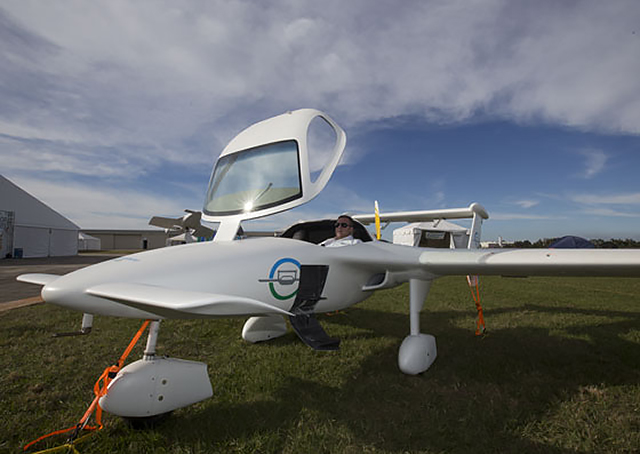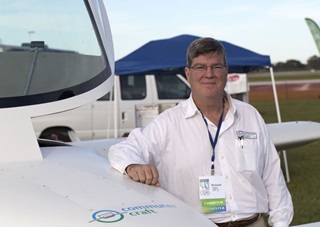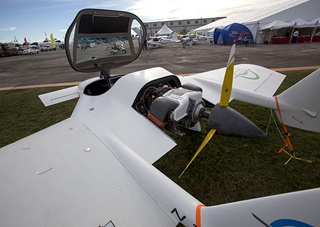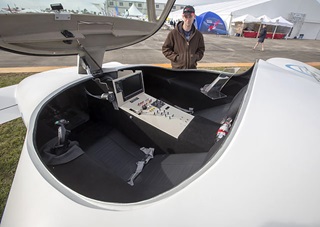
Test pilot Ethen Chaffin was prepared to fly on Sept. 24, 2015, the chosen day for the maiden flight of a brand-new, home-brewed design. He just wasn’t expecting it to happen quite so soon.
Models and math had told the small team behind Commuter Craft, a startup founded by homebuilder Richard Hogan, to expect the two-seat Innovator to lift off on its own (in the absence of aft stick) at 105 knots. Chaffin advanced the throttle, spinning the 180-horsepower Titan engine up to speed and accelerating down the nearly 6,000-foot runway at Cartersville Airport in Cartersville, Georgia, with his left hand steady on the sidestick, watching the airspeed wind up.
“It took me just a moment to realize I was off the ground,” Chaffin recalled, standing beside the distinctive white airplane on display at the U.S. Sport Aviation Expo in Sebring, Florida, nearly four months (and 28.3 flight test hours) after that first flight. “It came off the ground at 87 (knots)… it didn’t pitch up.”
Hogan was so excited he forgot to keep the camera pointed at his creation as it broke ground. About five years before that auspicious day, Hogan had retired early from his day job as the general manager and chief financial officer of a (nonaeronautical) engineering firm to complete a mission he had been working on in his spare time.

That first flight was more than a decade in the making, and in one respect the culmination of a dream dating to his boyhood, though it was also just the beginning. A longtime homebuilder actively involved in the Experimental Aircraft Association community, Hogan said he set out to make an airplane that is capable of covering distance at speed, an airplane that is exciting, unmistakably “new,” comfortable, and “very, very safe.” The Innovator, as he dubbed the design, has so far shown no signs of falling short of those goals.
On that first flight, Chaffin, the 26-year-old test pilot, realized he was already off the ground soon enough, and decided to let it fly. The short first flight of the first prototype produced a remarkably short list of tweaks and improvements to be made: minor adjustments to the suspension of the long, leggy landing gear, ailerons, and engine cooling.
It was the humans who overheated, so to speak.
“It was such a euphoric moment, we didn’t fly again that day,” Chaffin recalled. “We needed a couple of days to cool down.”
This unique two-seater is difficult to describe, with lines and features that invite comparison to some Rutan designs (it has a canard and a pusher prop) as well as manta rays. The wide body accommodates a wide cockpit (60 inches), with widely spaced seats and a huge center console between that is large enough to accommodate batteries that can drive the wheels for travel by road, with an expected road range of about 50 miles when that version is developed.

The design produces lift from tip to tail, with three primary airfoils: the canard, the wing, and the horizontal stabilizer. Technically, Hogan noted, it has four lifting bodies, including the fuselage.
He plans to give it folding wings, a design point in common with Terrafugia’s Transition, though Hogan emphasized that this craft is an airplane first, and a road vehicle second; it is designed to be a great airplane above all.
While he plans to build a light sport version (1,320 pounds maximum gross), this first prototype has so far been flown at 2,250 pounds gross; fiberglass wings account for some of that weight. The all-composite, folding-wing version will be able to adapt quickly to road travel, and another option will be to tow it home on a trailer.
While there are some similarities between the Innovator and the Transition, Hogan noted many differences, and said he has a different market in mind: The Innovator will be produced first as a kit, and will likely require two or three years to develop into a light sport version. It will have at least this much in common with the Terrafugia Transition.
“Nobody’s going to confuse either one of them with a 172,” Hogan said.
A flip of a switch in the spacious center console can move the rudder pedals forward or aft to accommodate pilots ranging in height from 5 feet 2 inches to 6 feet 4 inches tall; Hogan said the design will ultimately offer a comfortable ride (and consistent sight picture forward) for pilots up to 6 feet 8 inches tall.
It is scalable in other ways. Hogan anticipates his small startup company will eventually build versions with up to six seats, and the basic design can scale larger still.
“I’ve got a lot of ambitions for my little baby,” Hogan said.
Chaffin, so far the only pilot with firsthand knowledge of the results of the years-long effort, said the Innovator is an “absolute joy” to fly: responsive, steady, and as docile in a stall as can be. Power off and stick full aft produces a sink rate of 1,100 feet per minute, with no pitching, yawing, or rolling tendencies, he said. He has added turns to that profile, up to about 17 degrees of bank, and the aircraft has yet to spin. These characteristics, he said, will help make the dreaded base-to-final stall-spin scenario nearly impossible, part of the Innovator’s safety package. (An optional ballistic parachute will also be available, along with other safety features.)

Chaffin has logged speeds of 181 knots at 7,000 feet, and projected a range of 620 nautical miles at 55 percent power with an 8-gallon reserve. Those figures, along with the climb rate of 1,750 feet per minute at sea level, will be reconfirmed as the design is refined and new features (such as folding wings) and alternative powerplants are added.
Hogan expects to produce kits that can be completed for about $100,000 to $120,000, depending on avionics and other choices; the roadable version will be a bit more expensive, between $150,000 and $180,000.
He hopes to be able to fly it in front of the crowd at the Sun 'n Fun International Fly-In and Expo, where he will also announce details of an “alpha” and “beta” build program, with 10 experienced builders to be recruited in each of these categories. Largely self-funded to date, he also will be recruiting investors.
The Innovator has already demonstrated a remarkable ability to draw crowds, pilots and nonpilots alike. There was such great interest among patrons at the local Waffle House that they posted one of the design drawings on the wall, and Hogan noted that the aircraft has earned the admiration of men and women alike, including people who had never expressed much interest in airplanes before.
“We wanted an airplane that would inspire, and bring new people into aviation,” Hogan said.



